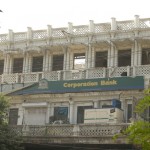Walking in old city of Delhi, 7 Feb 2010
- Chandni Chowk
- Chandni Chowk
- Chandni Chowk
- Chandni Chowk
- Chandni Chowk
- Chandni Chowk
- Chandni Chowk
We covered the main street of Chandni Chowk, from Digambar Jain Lal Mandir opposite Red Fort right up till the Fatehpuri area. The Jain temple and Gauri Shankar temple are the two most important temples in old Delhi. Their shikhars are most prominently visible from a distance. The first one is contemporary to Shah Jahan’s time (mid 17th century) and the second was built in 18th century. Next stop was SBI building which has recently undergone restoration. This entire area would originally have been Begam Samroo’s estate. It is now called Bhagirath Place & is a very large market for electronic goods. Close by is the Central Baptist Church built just after 1857 uprising. On the opposite side are the famous jalebiwala and Dariba Kalan, the street known for its silver jewellery. Next was Sisganj gurudwara, the fountain chowk and Sunheri masjid. The fountain & sisganj gurudwara mark the place of martyrdom of Guru Teg Bahadur & 3 of his followers. The fountain chowk also has the old Ghantewala halwai shop. It has now moved shop close by but a signboard still marks the original location of the shop. A further ahead is parathewali gali, probably the most famous street in old Delhi, known for its stuffed parathas. A little ahead is the Town hall, built by the British and now the office of the MCD. Katra Neel starts just after the Town hall. This area is known for Lala Chunna Mal’s haveli which can be seen on the first storey, above the cloth market on the ground floor. We entered katra neel through a red gateway. A plaque on the gateway tells us that this was the site of the shootout by the British on protesting nationalists in 1942 Quit India Movement. Katra Neel also has small shivalayas, shrines dedicated to Hindu god, Shiva. Entering the Fatehpuri masjid is a great contrast to the hustle bustle outside. The mosque is a very active place, full of students and locals, but still is very quiet and peaceful. The last stop was Urdu poet Ghalib’s haveli, where we ended the heritage walk.
(posted by Rajesh Ranjan & Kanika Singh, team members, Delhi Heritage Walks)








